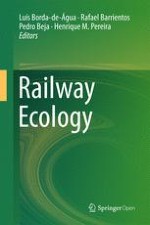A Bright Look at the Future of Railways
Emerging Trends and Challenges
Railways Travel Towards Environmental Sustainability
-
First and foremost, studies to evaluate the biodiversity impacts of railways and their mitigation measures need in most cases to be strengthened through the use of adequate designs, sufficiently large sample sizes, and sufficiently long time frames. Ideally, BACI (Before-After-Control-Impact) designs should be used to examine such impacts, avoiding simple designs that have little power to demonstrate causality (Balkenhol and Waits 2009; Corlatti et al. 2009; Soanes et al. 2013; see Chap. 12). Monitoring must be long-term, as some species need time to get used to disturbances associated with railway operation, and to the implementation of mitigation measures (Baofa et al. 2006; Yang and Xia 2008; Corlatti et al. 2009; Soanes et al. 2013).
-
Second, we still need better estimates of wildlife mortality in railways, though this is one of the most visible and well-studied impacts. Tackling this problem will require, for instance, field experiments on searcher efficiency and carcass persistence on railways (Barrientos et al. in review). These are expected to be railway-specific because, as commented in Chap. 1, traffic flow on railways is markedly lower than that of roads. This is important because low traffic flows allow time gaps for scavengers to have access to carcasses. On the other hand, trains travel over rails, and corpses falling out of them can persist longer as there is no flattening as it may happen in roads.
-
Third, we need a better understanding on the barrier and fragmentation effects of railways, and how these may act together with those of other linear structures such as roads (see, e.g., Chap. 14). Concurrently, we need to know where, when and how can wildlife passes effectively mitigate such barrier and fragmentation effects, by helping to restore connectivity across the landscape. A range of studies may contribute to such understanding, including comparisons of wildlife crossings of railways before and after the building of wildlife passes, in places with and without such passes (i.e., BACI designs; Corlatti et al. 2009; Soanes et al. 2013). Novel molecular techniques may also contribute to tackle these issues, using for instance non-invasive genetics to know which individuals cross the railways and how railway barriers contribute to spatial genetic structuring (Riley et al. 2006; Balkenhol and Waits 2009; Clevenger and Sawaya 2010; Simmons et al. 2010; see also Chap. 4). Modelling approaches may also be useful to explore the demographic and genetic consequences of barrier effects induced by railways, and to disentangle barrier from mortality effects (Borda-de-Água et al. 2011, 2014; Ceia-Hasse et al. 2017).
-
Fourth, we need to know if and how mortality and barrier effects translate into population effects, which in turn can affect the persistence of vulnerable species around railway corridors (van der Grift 1999; Dorsey et al. 2015). This might be achieved through population modelling approaches similar to those already used in road ecology (Taylor and Goldingay 2009; van der Ree et al. 2009; Borda-de-Água et al. 2014; Ceia-Hasse et al. in review). The development of these models require careful field studies whereby critical information on fecundity, survival and dispersal are estimated, which can then be used to estimate the conditions under which population viability may be affected by railways. Due consideration should also be given to age- and sex-specific demographic parameters, as huge variation in population responses may occur if mortality affects primarily non-breeding versus breeding individuals, or males versus females. Molecular methods may also contribute to understand population responses to railways, either by helping to estimate population parameters, or to evaluate changes in effective population sizes in relation to mortality and fragmentation effects (Balkenhol and Waits 2009).
-
Fifth, we need studies on railway ecology focusing on a wide range of species, which should be representative of life history and behavioural traits potentially affecting vulnerability to railways. To date, most research has focused on species with high socio-economic profile, like large charismatic mammals, or on those with limited mobility, like herptiles (van der Grift 1999; Dorsey et al. 2015). Broadening the scope of research is important, because mitigation measures designed for some species may be inappropriate for others, thus requiring informed adjustment based on scientifically sound information (Clevenger and Waltho 2005; Morelli et al. 2014; Vandevelde et al. 2014; Wiacek et al. 2015; see Chap. 16). To forecast impacts on species with differential traits, pilot field studies and a systematic review of the available evidence should be carried out to investigate what are the key ecological traits, such as dispersal ability or generation time, affecting population responses to railways.
-
Finally, there are a number of important issues that remain poorly explored, despite their potential importance to the environmentally-sound management of railways. For instance, little is known about the consequences of vibration and noise on biodiversity living adjacent to the railway bed (see Chap.6). Also, studies are needed on the relative cost-effectiveness of different management tools and mitigation measures to help reconcile environmental protection and socio-economic demands (see, e.g., Andreassen et al. 2005; Ford et al. 2009; Mateus et al. 2011). The potential positive impacts of railways also need to be better explored, including in particular the prospective for the right-of-way to act as a shelter for biodiversity (see Chap. 16), which can probably be improved through well-designed wildlife-friendly management procedures.
